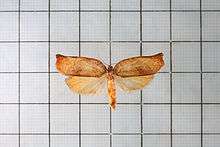Homona coffearia
| Homona coffearia | |
|---|---|
 | |
| Scientific classification | |
| Kingdom: | Animalia |
| Phylum: | Arthropoda |
| Class: | Insecta |
| Order: | Lepidoptera |
| Family: | Tortricidae |
| Genus: | Homona |
| Species: | H. coffearia |
| Binomial name | |
| Homona coffearia (Nietner, 1861) | |
| Synonyms | |
| |
Homona coffearia, the tea tortrix or camellia tortrix, is a moth of the family Tortricidae. It is widely distributed in the Oriental region.[1]
The wingspan is 16–20 mm for males and about 23 mm for females. The ground colour of the forewings in males is greyish brown, with brown markings and a darker spot at the costa. The hindwings are dark fuscous. In females, the forewings are pale-brown, almost without distinct markings. Adults are on wing between December and April in Sri Lanka.[2] There are two generations per year in China with adults appearing in late May.
The larvae feed on Acacia auriculiformis, Arachis hypogaea, Bauhinia, Cajanus indicus, Calophyllum inophyllum, camellia sinensis, Cinnamomun, Citrus, Coffea, Crotalaria, Derris, Eucalyptus alba, Eugenia polyantha, Glochidion, Gossypium, Linum, Melochia indica, Nephelium, Pluchea indica and Pyrus. Newly hatched larvae mostly move upwards to the growing points of their host plant and begin feeding. From the second to the fifth and final instar, they make nests by webbing two or more leaves together. A single larva usually makes several nests. Pupation takes place within the final nest.